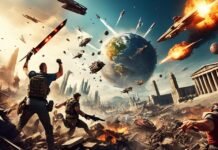World War II, or ww, was a global conflict that took place from 1939 to 1945, involving most of the world’s nations forming two opposing military alliances: the Allies and the Axis powers. This war was the largest and most devastating global conflict in human history, with over 70 million fatalities worldwide. The war had a profound impact on the political, economic, social, and cultural landscapes of the world, reshaping the global order and paving the way for the modern era.
But how well do you truly know the incredible stories and lasting legacies of ww? What pivotal moments and legendary figures defined this epic global struggle? Join us as we uncover the remarkable world of ww and discover the profound ways it continues to shape our world today.
Key Takeaways
- ww was the largest and most devastating global conflict in human history, involving most of the world’s nations.
- The war had a profound impact on the political, economic, social, and cultural landscapes of the world.
- ww reshaped the global order and paved the way for the modern era.
- Legendary leaders and military figures on both the Allied and Axis sides played a crucial role in shaping the war’s outcome.
- The legacy of ww is preserved through a vast network of memorials, museums, and historical sites around the world.
Unveiling the Mysteries of ww
World War II, or ww, was a global military conflict that lasted from 1939 to 1945, involving most of the world’s nations forming two opposing military alliances: the Allies and the Axis powers. It was the largest and most devastating war in human history, with over 70 million fatalities worldwide.
What is ww?
ww, also known as the Second World War, was a global conflict that erupted in 1939 and lasted until 1945. It was a war of unprecedented scale and destruction, with battles raging across the continents of Europe, Asia, Africa, and the Pacific. The war involved the mobilization of over 100 million military personnel, making it the largest armed conflict in the history of humanity.
The Historical Significance of ww
The ww had a profound impact on the political, economic, social, and cultural landscapes of the world. It led to the collapse of colonial empires, the rise of superpowers like the United States and the Soviet Union, and the establishment of the United Nations. The postwar period also saw the emergence of the Cold War, a geopolitical tension between the capitalist West and the communist East that would shape global affairs for decades.
The Global Impact of ww

The global impact of ww was far-reaching and profound. Politically, the war led to the collapse of colonial empires, the rise of superpowers like the United States and the Soviet Union, and the establishment of the United Nations. The postwar period also saw the emergence of the Cold War, a geopolitical tension between the capitalist West and the communist East that would shape global affairs for decades.
Political Consequences
The ww altered the political landscape of the world, ushering in a new era of superpower dominance and the formation of international organizations. The collapse of colonial empires, such as the British and French, paved the way for the independence of many nations, particularly in Africa and Asia. The United Nations was established in the aftermath of the war, providing a platform for global cooperation and conflict resolution. The emergence of the Cold War, a period of heightened tensions between the capitalist West, led by the US, and the communist East, led by the Soviet Union, would shape global politics for the next four decades.
Economic Repercussions
The economic impact of ww was catastrophic, with widespread destruction of infrastructure, disruption of trade, and immense financial costs. Many nations faced severe economic hardship in the postwar period, leading to the need for extensive reconstruction and the implementation of new economic policies. The war also accelerated the shift towards a more globalized economy, as nations sought to rebuild and reestablish trade relationships. The Marshall Plan, implemented by the United States, played a crucial role in the economic recovery of Western Europe, helping to lay the foundation for its eventual prosperity.
Social and Cultural Shifts
The ww had a profound impact on the social and cultural fabric of societies around the world. The massive loss of life, the displacement of millions of people, and the widespread trauma of the war led to significant social upheaval. The role of women in the workforce and society was transformed, as they took on previously male-dominated roles during the war. The war also accelerated the process of decolonization, as subjugated peoples sought to assert their independence and assert their own cultural identities. The postwar period saw the emergence of new cultural movements, such as the Beat Generation in the United States and the Existentialist philosophy in Europe, which reflected the changing societal attitudes and the search for meaning in the aftermath of the devastating conflict.
ww: A Catalyst for Change
World War II (ww) was a catalyst for a myriad of technological advancements that would shape the world for decades to come. The war’s demands for more efficient and powerful weaponry, transportation, and communication systems led to rapid developments in fields such as aeronautics, nuclear physics, and computer science.
Technological Advancements
The invention of radar, jet engines, and the first programmable computers were all direct products of the wartime effort. The race to develop more advanced military technologies drove groundbreaking innovations that would have far-reaching implications long after the world war two had ended. These technological breakthroughs not only influenced the course of the war but also paved the way for the modern era of digital communication, air travel, and scientific research.
Redefined Geopolitical Landscape
In addition to technological advancements, World War II also redefined the global geopolitical landscape. The war led to the collapse of colonial empires, the rise of superpowers like the United States and the Soviet Union, and the establishment of the United Nations. The postwar period also saw the emergence of the Cold War, a geopolitical tension between the capitalist West and the communist East that would shape global affairs for decades.
Key Battles and Campaigns of ww

The Second World War, or ww, was marked by numerous pivotal battles and military campaigns that shaped the course of the conflict and ultimately determined its outcome. These strategic engagements not only showcased the bravery and resilience of the combatants but also highlighted the technological advancements and tactical innovations that emerged during this global crisis.
One of the most iconic ww battles was the Battle of Stalingrad, a brutal and protracted urban battle that lasted from July 1942 to February 1943. The Soviet defense of the city against the invading German forces was a turning point in the war, marking the first major defeat of the Nazi war machine and signaling the beginning of the end for the Axis powers.
| Key Battle | Location | Outcome |
|---|---|---|
| Battle of Stalingrad | Stalingrad, Soviet Union | Soviet victory, a turning point in ww |
| Battle of Normandy | Normandy, France | Allied victory, led to the liberation of Western Europe |
| Battle of Midway | Pacific Ocean | Allied victory, a major setback for the Japanese in the Pacific |
| Battle of Kursk | Kursk, Soviet Union | Soviet victory, the largest tank battle in history |
Another pivotal engagement was the Battle of Normandy, also known as D-Day, which saw the Allied forces launch a massive amphibious invasion of Normandy, France, in June 1944. This successful operation marked the beginning of the liberation of Western Europe from Nazi occupation and paved the way for the eventual surrender of Germany.
In the Pacific theater, the Battle of Midway in June 1942 was a critical victory for the Allies, as it turned the tide of the war against the advancing Japanese forces. This naval battle, considered one of the most significant in maritime history, dealt a devastating blow to the Japanese and allowed the Allies to go on the offensive in the Pacific.
The Battle of Kursk, fought in the summer of 1943, was the largest tank battle in history and a major victory for the Soviet forces. This engagement marked the end of the German’s last major offensive on the Eastern Front and paved the way for the Red Army’s subsequent advances, ultimately leading to the fall of Berlin and the Axis powers’ surrender.
Legendary Leaders and Figures of ww
The ww era witnessed the rise of several legendary leaders and military figures on both the Allied and Axis sides, whose decisions and actions shaped the course of the global conflict. From the visionary strategists to the charismatic commanders, these individuals left an indelible mark on the history of the second world war.
Allied Forces
On the Allied side, key figures included the esteemed American general Dwight D. Eisenhower, who served as the Supreme Allied Commander in Europe and orchestrated the successful Normandy landings. British Prime Minister Winston Churchill was a towering statesman who rallied his nation and the Allies through the darkest hours of the war. The brilliant Soviet military leader, Joseph Stalin, played a pivotal role in the defeat of the Axis powers on the Eastern Front.
Other notable Allied leaders were Franklin D. Roosevelt, the US President who guided his country through the war, and Charles de Gaulle, the influential French general who led the Free French forces in the fight against Nazi occupation. These visionary individuals, along with countless brave soldiers, sailors, and airmen, secured victory for the Allied powers.
Axis Powers
On the Axis side, the infamous German dictator Adolf Hitler was the driving force behind the war, pursuing his twisted vision of a Nazi-dominated Europe. His lieutenants, such as Heinrich Himmler and Hermann Göring, were instrumental in implementing the genocidal policies of the Third Reich. In Italy, Benito Mussolini aligned his fascist regime with the Axis, while in Japan, Hideki Tojo served as the country’s Prime Minister and a key architect of its military expansion.
These larger-than-life figures, both on the Allied and Axis sides, left an indelible mark on the ww era, their decisions and actions shaping the course of the most devastating conflict in modern history.
The Allied Victory and the End of ww
After years of fierce fighting and enormous sacrifices, the Allies emerged victorious in the Second World War, or ww. The turning point came in 1943 when the tide of the war began to shift in favor of the Allies, with significant victories such as the Battle of Stalingrad and the Battle of Kursk.
Surrender of Axis Powers
As the Allies advanced on multiple fronts, the Axis powers began to crumble. In 1945, Germany surrendered unconditionally, marking the end of ww in Europe. Shortly after, Japan also surrendered following the devastating atomic bombings of Hiroshima and Nagasaki, effectively bringing the global conflict to an end.
Post-War Reconstruction
The aftermath of ww left the world in ruins, with vast swaths of Europe and Asia devastated by the ravages of war. The Allied nations, led by the United States and the Soviet Union, embarked on an extensive reconstruction effort to rebuild shattered economies and infrastructure. This period of post-war reconstruction was crucial in shaping the new global order and paving the way for the rise of the superpowers that would dominate the world stage in the decades to come.
Remembering ww: Memorials and Museums
The legacy of ww, or World War II, is preserved through a vast network of memorials, museums, and historical sites around the world. These institutions serve as powerful reminders of the sacrifices made and the lessons learned during this global conflict.
Significant Sites and Monuments
From the iconic Normandy American Cemetery and Memorial in France to the National World War II Memorial in Washington D.C., these sites stand as solemn testaments to the immense bravery and resilience of the Allied forces and the civilians who endured the horrors of wwii. Visitors can walk the grounds, explore the exhibits, and pay their respects to the fallen heroes who sacrificed everything to secure victory.
Preserving the Legacy
Museums dedicated to ww offer an immersive and educational experience, allowing visitors to delve deeper into the historical events and their lasting impact. Institutions like the National World War II Museum in New Orleans and the Imperial War Museums in the United Kingdom curate extensive collections, interactive displays, and thought-provoking exhibits that bring the legacy of this pivotal era to life.
Through these memorials and museums, the memories and lessons of ww are preserved, ensuring that the sacrifices made and the hard-earned victories will never be forgotten. These historical sites serve as a powerful reminder of the resilience of the human spirit and the enduring importance of standing up against tyranny and oppression.
ww in Literature and Popular Culture
The legacy of ww has been profoundly reflected in literature, film, and popular culture. Countless books, from historical accounts to fictionalized narratives, have explored the various aspects of the war, from the battlefield to the home front.
Books and Films
Iconic novels like “The Thin Red Line” by James Jones, “Slaughterhouse-Five” by Kurt Vonnegut, and “Catch-22” by Joseph Heller have captured the gritty realities and absurdities of war, while offering poignant commentary on the human condition. Acclaimed films such as “Saving Private Ryan,” “Band of Brothers,” and “The Pianist” have brought the experiences of ww to life on the silver screen, immersing audiences in the harrowing struggles and heroic moments of the conflict.
Video Games and Media
The widespread fascination with ww has also extended into the realm of video games and other media. Immersive first-person shooter games like “Call of Duty” and “Medal of Honor” have allowed players to virtually experience the intensity of combat, while strategy games like “Hearts of Iron” and “Company of Heroes” have challenged them to navigate the complex geopolitical landscape of the war. Documentaries, TV series, and historical podcasts have also played a crucial role in educating and captivating audiences about the events and legacies of ww.
Through these diverse mediums, the stories, sacrifices, and triumphs of ww have been immortalized, ensuring that the lessons and the human experiences of this pivotal period in history continue to resonate with generations to come.
FAQ
What is ww?
ww, or World War II, was a global military conflict that lasted from 1939 to 1945. It was the largest and most devastating war in human history, involving most of the world’s nations forming two opposing military alliances: the Allies and the Axis powers.
What was the historical significance of ww?
The war had a profound impact on the political, economic, social, and cultural landscapes of the world, reshaping the global order and paving the way for the modern era.
What were the key political consequences of ww?
Politically, the war led to the collapse of colonial empires, the rise of superpowers like the United States and the Soviet Union, and the establishment of the United Nations. The postwar period also saw the emergence of the Cold War, a geopolitical tension between the capitalist West and the communist East that would shape global affairs for decades.
How did ww impact the global economy?
The economic repercussions of ww were far-reaching, as the war devastated many countries’ industrial and financial systems. The postwar period saw the rise of new economic powers, the development of international organizations like the World Bank and the International Monetary Fund, and the implementation of the Marshall Plan to aid in the reconstruction of Europe.
What were the social and cultural shifts caused by ww?
ww had a profound impact on social and cultural landscapes around the world. The war led to the breakdown of traditional societal structures, the empowerment of women, and the emergence of new cultural movements. The postwar period also saw the rise of the civil rights movement and the decolonization of many nations.
What were the key technological advancements that came out of ww?
ww was a catalyst for a myriad of technological advancements that would shape the world for decades to come. The war’s demands for more efficient and powerful weaponry, transportation, and communication systems led to rapid developments in fields such as aeronautics, nuclear physics, and computer science. The invention of radar, jet engines, and the first programmable computers were all direct products of the wartime effort.
How did ww reshape the geopolitical landscape?
The war led to the collapse of colonial empires and the rise of two superpowers, the United States and the Soviet Union, who would go on to shape the geopolitical landscape for decades through the Cold War. The postwar period also saw the establishment of new international organizations like the United Nations, which aimed to prevent future global conflicts.
What were some of the key battles and military campaigns of ww?
ww was marked by numerous key battles and military campaigns that shaped the course of the war and determined its eventual outcome. Some of the most significant include the Battle of Stalingrad, the Battle of Normandy, the Battle of the Atlantic, and the Pacific campaigns.
Who were the legendary leaders and figures of ww?
ww was marked by the rise of legendary leaders and military figures on both the Allied and Axis sides. On the Allied side, key figures included Winston Churchill, Franklin D. Roosevelt, and Dwight D. Eisenhower. On the Axis side, figures like Adolf Hitler, Benito Mussolini, and Hirohito played pivotal roles in the conflict.
How did the Allies achieve victory in ww?
After years of fierce fighting and enormous sacrifices, the Allies emerged victorious in ww. The turning point came in 1943 when the tide of the war began to shift in favor of the Allies, with significant victories such as the Battle of Stalingrad and the Battle of Kursk. The final defeat of the Axis powers came in 1945 with the surrender of Germany and Japan.
How is the legacy of ww preserved through memorials and museums?
The legacy of ww is preserved through a vast network of memorials, museums, and historical sites around the world. These institutions serve as powerful reminders of the sacrifices made and the lessons learned during this global conflict, ensuring that the memory of ww is kept alive for future generations.
How has ww been reflected in literature and popular culture?
The legacy of ww has been profoundly reflected in literature, film, and popular culture. Countless books, from historical accounts to fictionalized narratives, have explored the various aspects of the war, from the battlefield to the home front. Similarly, a vast array of films, video games, and other media have captured the drama, tragedy, and heroism of this pivotal moment in history.

























































